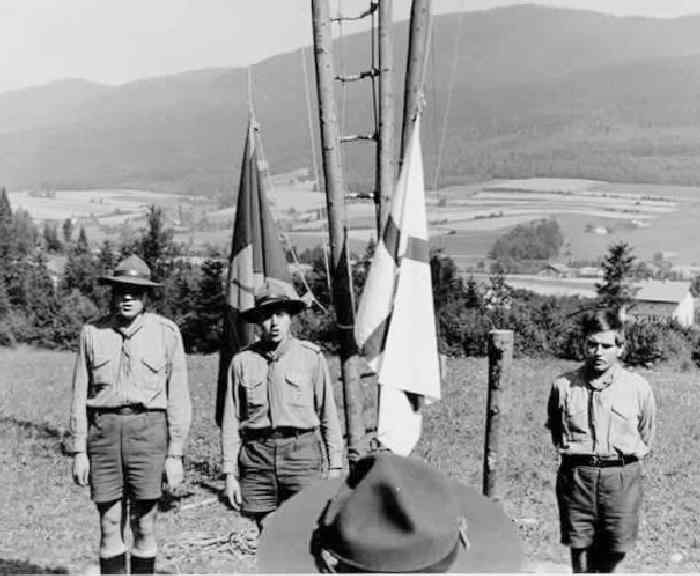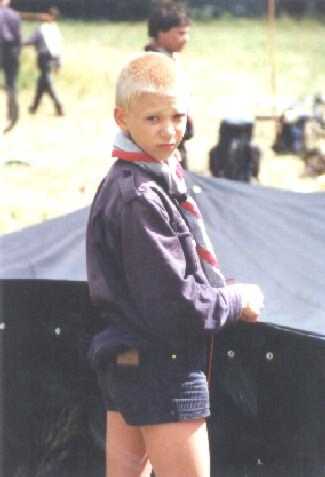
German Scouting / Pfadfinder : Historical Periods

Figure 1.--Here we see some German Scouts. I do not know what the flags represent. Nor do I know when the photograph was taken. Note that the boys do not have any badges on their shirts. I wonder if this could mean that it could be right after World War Ii and the Scouting movement was just getting started,
|
|
We have some limited historical information on German Scouting--Pfadfinder. Scouting has never been a dominant youth movement in Germany as it was in many European countries. Unlike many countries, Germany had its own well established youth movement--the Wandervogel. Baden Powell considered the Wandervogel as a kind of German Boy Scouts. World War I occurred only a few years after Scouting was founded. After the War, Scouting was part of a a very diverse German youth movement. It may have been impaired to some degree by its association with the British. Scouting was banned by the NAZIs when they seized power in 1933. After World War II Scouting was revived in the western occupation zones of Germany, but banned by the Communists in the Soviet occupation zone. . We are not sure how popular Scouting was in West Germany. By the 1970s, however, the idea of wearing a uniform begame rather unpopularin Germany and serious attention to uniforms virtually disappeared.
We have little historical information on German Scouts. The first important German youth movement was Wandervogel. Scouting in Germany began soon after the Movement was founded in Britain. German Scouting or Pfadfinderen was founded (1909). We are yet sure who the individuals were that founded Scouting. We have little information about early German Scouts. The uniform was destinctive. Many other countres copied the British Scout uniform. The German Scouts had a kind of South Africa bush hat and wore knickers rather than short pants.
We know that Scouting developed in Germany in the early-1910s as it did throughout Europe. As in many other European countries, separate Scout associations were fornmed by different groups, primarily on religious lines. We are not entirely sure just when this process began. As far as we know there was no one Scout Association, although our information on the early movement is very limited. Scouting does not appear to have been as popular in Germany as in other European countres. A factor here may have been the association in the poublic mind with Britain. World War I erupted only a few years after Scouting was founded. We do not yet have much information on German Scouting during the War, both how it fared and what part it played in the War.
After World War I, other competing youth groups formed. Many religious groups founded youth movements or sposored Scout units. In addition, several of the political parties, not just the NAZIs with the Hittler Youth, had their own competing youth movements, separate from Scouting. The Communists who had many adherents in the 1920s, taking their cue from the Soviets did not approve of Scouting. After the mid 1920s the Hitler Youth movement gained in popularity. Until the NAZIs seized power in 1933 that the Germans had a strong Scout movement, although it did not dominate youth organizations as was the case in many other countries. It was not, however, the dominate youth group as it was in America, France and England. Although the Wandervogel had declined, the major political parties as well, as religious groups had organized their own youth groups.
German had one of the most vigorous and diverse youth movements in the world. This changed with the rise of the NAZIs. The NAZIs upon seizing power in 1933, abolished or incorporated the Scouts and almost other competing youth groups. The Catholic youth groupments were exempted at first, but were aslso eventaully eliminated. Many facilities of the Scouts and other youth groups were seized by the Hitler Youth, a practice they followed in areas with German populatiions incorporated into the Reich. Thus the only youth groups available to German children was the Hitler Youth. Here participation was not at first mandatory. Mosdt German children eventully had to join the Hitler Youth. An intreaguing study of Scouting in occupied countries during the War is available. After the NAZIs seized power, competing youth movements were abolished or incorporated into the Hitler Youth. The Catholic groups were at first excepted. Everntually participation in the Hitler Youth was made manditory for all Aryan German youth.

Figure 2.--Scouting was reintroduced in Germany after World War II. Uniforms declned in popularity during the 1970s, but were maintained by some groups. Several groups wore uniform shirts, but not uniform pants.
|
|
Only after the defeat of the NAZIs in 1945 were the Scouts allowed to reorganize in Germany. After World War II Scouting was reestablished in Federal Republic (West Germany). The Allies at first put limitations on Scouting activities. Here the concern was the role that the Hitler Youth had played in preparing boys for war. The Doviets in their zone, however, banned Scouting. And in German Democratic Republic (East Germany) and boys and girls had to join the state-sponsored Young Pioneers. After unification the Pioneers quickly disappeared and Scouting is now available to all German boys. Scouting was very popular with German boys in the 1950s and 60s, but I'm less sure about the current status of Scouting. I believe that the groups established did not give serious attention to uniforms, presumably concerned anout the Hitler Youth tradition. Lederhosen were often worn as Scout shorts. The Young Pioneers in East German seem less concerned about the uniform issue.
Late-20th Century
Uniforms declined in popularity during the late 20th century. Several different Scvout associations operated. Many Scout groups gave only minimal attention to uniform. Some boys wore Scout shirts and knerchiefs, but with jeans. Some boys wore virtually no uniform, except sometimes the kerchief. Uniform standards, however, varied significantly from group to group. Some groups did, however, continue to insist on uniforms.
While I have been able to find little information on German Scouting in English, there is some German language material. Im Jahr 1909 entstanden in Deutschland erste Pfadfindergruppen. Lions Buch "Das Pfadfinderbuch" war der Versuch, das Werk Baden-Powells auf deutsche Verhältnisse zu übertragen. Das führte dazu, daß der den kaiserlich-deutschen Verhältnissen
angepaßte Scoutismus als Mittel der vormilitärischen Jugenderziehung genutzt wurde. Entsprechend große Unterstützung fand die Idee in Militärkreisen. Die um die Jahrhundertwende aufgekommene bündische Jugendbewegung hatte zunächst keine Berührungspunkte mit den Pfadfindern - die beiden verschiedenen Konzeptionen wurden vor dem ersten Weltkrieg nicht in
Verbindung gebracht. 1913 fand als Gegenveranstaltung zur 100-Jahr-Feier der Völkerschlacht in Leipzig, die mit viel Pomp und Gloria begangen wurde, der Freideutsche Jugendtag auf dem Hohen Meißner statt. Während die dem Kaiserreich doch recht nahestehenden Pfadfinder hauptsächlich in Leipzig anzutreffen waren, war die bündische Jugend fast nur auf dem hohen
Meißner vertreten. Sie traten für die Einheit der deutschen Völker gegen Kleinstaaterei und Lokalpatriotismus und gegen die wilhelminische Vereinnahmung der Jugend ein. Nach dem Krieg gab es mehr Berührungspunkte zwischen Bündischen und Pfadfindern, es entstanden zwischen den "Urbündischen" und den "Scoutistischen" verschiedene Mischformen, die Elemente
aus beiden Konzeptionen in sich vereinigten: Pfadfinderbünde, Jungenschaften, Jungscharen, Horten, Jugendbünde, Wandervögel, Zugvögel, usw. Heute gibt es zahlreiche Gemeinsamkeiten. So entstammen "urpfadfinderische" Elemente wie Kohten, Jurten, Jujas und viele unserer Lieder der bündischen Tradition. Dennoch ist die Unterschiedlichkeit Pfadfinder/Bündische nach wie vor anzutreffen. Der größte Unterschied ist wahrscheinlich das Erziehungskonzept der Pfadfinder, daß die Bündischen ablehnen (auch wenn sie z. T. in der Praxis vieles davon übernommen haben). Auf dem
Meißnerlager 1988, das aus Anlaß des 75jährigen Jubiläums des freideutschen Jugendtages stattfindet, waren auch zahlreiche Pfadfinder vertreten.
HBU

Navigate the Historic Boys' Uniform Chronology Pages:
[Return to the Main chronologies page]
[The 1900s]
[The 1910s]
[The 1920s]
[The 1930s]
[The 1940s]
[The 1950s]
[The 1960s]
[The 1970s]
[The 1980s]
[The 1990s]
[The 2000s]
Navigate the Historic Boys' Uniform Web Site:
[Return to the Main German Scouting page]
[Introduction]
[Activities]
[Biography]
[Chronologies]
[Countries]
[Essays]
[Garments]
[Organizations]
[Other]
[Bibliographies]
[Contributions]
[FAQs]
[Questions]
[Unknown images]
[Boys' Uniform Home]
Navigate the Historic Boys' Uniform Web organization pages:
[Return to the National Scout page]
[Return to the Main German page]
[Boys' Brigade]
[Camp Fire]
[Hitler Youth]
[National]
[Pioneers]
[Royal Rangers]
[Scout]
Created: 2:13 AM 5/15/2005
Last updated: 2:42 AM 8/25/2010




